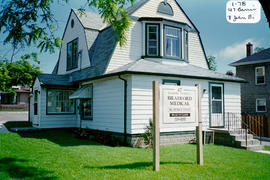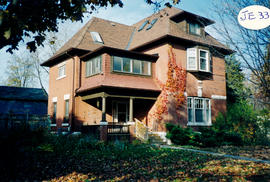7 John Street East - The Tindall House
- CA BWGPL GJ-HB-2017-04-04-01
- Pièce
- 1996
Fait partie de George Jackson fonds
The Tindall House is located at 7 John St. East (on the northeast corner of John and Barrie Streets). It was built by Isaac Coburn around 1910-20 in the Dutch Colonial Revival style. The house was built for Reuben Tindall (an implement dealer), his wife, and daughter Ida Evelyn (a school teacher). Dr. S. Hecking bought the property after WWII. He moved here from the northeast corner of Barrie and Holland Streets. His office was also in this structure. Its address was 47 Barrie Street. The building was eventually sold (in 1994) to Giuseppe (Joe) Campagnola. He has leased the doctor’s office since then and still owns the building in 2014.
The 1½-storey, two-bay house has a simple form with an asymmetrical façade and a rectilinear plan. The building has a steeply-pitched, gambrel roof with a gambrel-roofed dormer. The one-storey wings (reminiscent of the Classical Revival style) are reinterpreted here more modestly as entrance porches. There is an off-centre, hall entrance from an enclosed, front entrance porch. The raised porch has a shallow hip roof and is entered from the front. It has frame construction and is clad and finished as part of the main portion of the house (rather than a separate, attached structure). There are wide window openings with low floor to ceiling heights. The double window and door are set into rectangular frames of plain wood. The ground-floor and basement windows and the front door are set into segmented, arched openings with concrete sills. Second-storey dormer windows and a bay window are centred within the gambrel form and are offset from the ground-floor openings. This creates a more informal composition common to twentieth-century buildings. The original, multi-paned windows have plain, wood sills and trim. Front, ground-floor and second-floor windows are not original. The roof material appears to be a siding on the steep, roof slope. A wood fascia band, expressing the line of the floor structure between the foundation and ground floors, is common to this style. The house has wood frame construction, vinyl siding, and a textured, concrete-block foundation. The original siding was wood. According to the 2000 inventory, the building is in excellent condition with many well-maintained, original features. (1, 2, 3)
Sans titre


